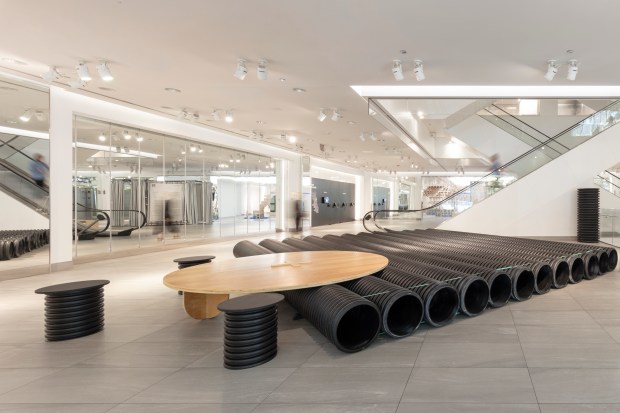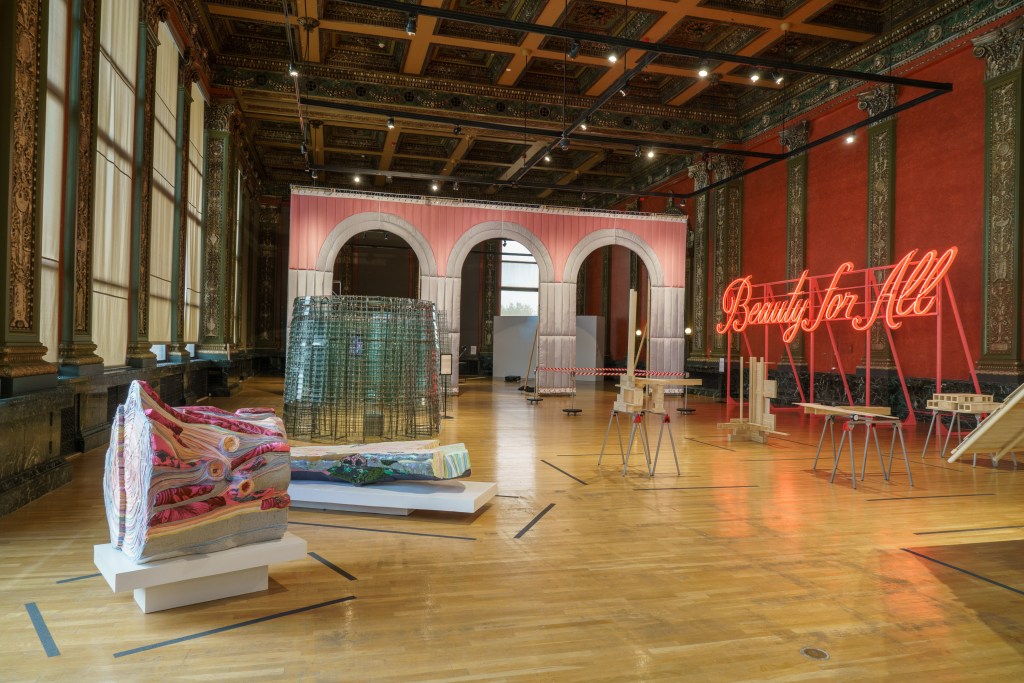The best news in architecture is the sixth edition of the Chicago Architecture Biennial. “SHIFT: Architecture in Times of Radical Change” has put up 100-plus projects from around the globe at sites across the city through the end of February. Led by Florencia Rodriguez, an Argentinian who most recently directed UIC’s School of Architecture, CAB 6 surveys how architecture can help make the world more sustainable, more affordable, and more just for everyone. There’s even a hot pink neon billboard, by R&R Studios of Miami, proclaiming “Beauty for All.” Plus it’s free.
The worst news in architecture is the reliance on fossil fuels and unsustainable raw materials, a global epidemic of homelessness and the kind of destruction that occurs in wartime. CAB 6 stands for the opposite of all this, so it was unsettling to learn that some of its funding has come from the Crown Family Philanthropies, which owns a 10% stake in General Dynamics, the fifth-largest defense company and maker of military hardware in the world. The day before CAB 6 opened, a coalition of participants withdrew in protest.
If “SHIFT” could be said to have a single guiding principle, it would be reuse. The concept is applied broadly throughout the biennial’s multiple “capsules,” or mini-exhibits within the mega-exhibit, and offers innovative approaches to outmoded structures, common supplies, and vernacular styles. Subjects include the discothèque and also the traditional adobe fireplaces of Central Europe, a 285-foot-long bench made of Lake Titicaca reeds and a study of the self-organized markets of Lagos. Something worthwhile can be learned from each.
Chicago Architecture Biennial opens this weekend, bringing a world of architectural ideas to town
Some of the exhibited reuse ventures have already succeeded. An elegant, slatted wooden tower with built-in seating stands in for a decommissioned wood granary in Sturgeon Bay, Wisconsin, slated for demolition but remade by the architecture firm La Dallman into a site for cultural events and educational tours. Tearing it down would have dumped tons of wood, metal and concrete, as well as a central part of the town’s history, into the landfill. Other reuse ideas are purely speculative, like a dream of New York City as a genuinely accessible place, with colorful exterior ramps and elevators encircling existing tenement blocks. There’s Buenos Aires circa 2075, with favelas taking to the skies, suspended above a sea of mud on scaffolding attached to no-longer-inhabitable buildings. The display models could not be more charming, though the situations addressed are dead serious.
Many of the materials used by participating architects will go back into circulation when the biennial is over: bricks bound together with web straps to form a giant makeshift playground on the lawn of the Museum of Science and Industry, glass offcuts tiled into a gleaming pavilion in the Cultural Center, heavy-duty corrugated pipe fashioned into cool lobby furniture at 840 N. Michigan Avenue, CAB’s felicitous new venue. A shuttered H&M store, it serves as a model for what to do with all that empty Loop property. No doubt the owners hope to have it commercially leased again soon.
Chicago artist Jason Campbell assembled “The Linen Closet” by hanging salvaged comforters on a hand-carved wooden frame. Inside the quiet space are benches for sitting and reading the story tags affixed to each blanket. On view at the Cultural Center as part of Chicago Architecture Biennial 6, titled “SHIFT: Architecture in Times of Radical Change.” (Robert Chase Heishman)

Part of Chicago Architecture Biennial 6, a venue at 840 N. Michigan Ave. is a former multi-level retail store. The lobby has been outfitted with furnishings designed by Bair Balliet using heavy-duty corrugated pipe that will go back into circulation once the biennial is over (Pablo Gerson)

In the fourth-floor lobby of the Cultural Center, architect Iman Fayyad of project:if has created a cozy, curvy pavilion out of bent wood stitched together with red straps.Part of Chicago Architecture Biennial 6, titled “SHIFT: Architecture in Times of Radical Change.” (Robert Chase Heishman)
Show Caption
1 of 3
Chicago artist Jason Campbell assembled “The Linen Closet” by hanging salvaged comforters on a hand-carved wooden frame. Inside the quiet space are benches for sitting and reading the story tags affixed to each blanket. On view at the Cultural Center as part of Chicago Architecture Biennial 6, titled “SHIFT: Architecture in Times of Radical Change.” (Robert Chase Heishman)
The U.N. recently reported that nearly 3 billion people worldwide are inadequately housed, hence the prominence accorded to housing innovations in “SHIFT.” These vary widely in scale, from a 38-story tower that sensitively adds 500 units in central Buenos Aires to a modest floating platform designed to harvest solar power, collect rainwater, and provide basic hygiene needs for river dwellers in Latin America. The latter is presented via a simple video; Natura Futura used its CAB 6 budget to actually build and install “The Collector” on the Babahoyo River in Ecuador. Indeed, housing is the one area in which “SHIFT” presents mostly completed, real-world projects, primarily via “Inhabit, Outhabit,” a smartly produced three-channel film, projected huge in a dedicated space on the fourth floor of the Cultural Center. It features 29 collective housing projects from around the world, among them a cohousing facility for artists and their families in London, where rent is reduced in exchange for residents offering free creative programing to the neighborhood; 16 new bioclimatic dormitories for students at the University of Dakar; a 15-apartment complex in central Basel erected on a seemingly impossible lot hemmed in by parking lots and party walls; and a rounded apartment tower with ample communal spaces in Shenzhen inspired by the Hakka, a traditional southern Chinese dwelling. If you don’t already want to be an architect, you will after watching this inspiring documentary. Or at least, I did.
As with any large cultural event these days, multiple conferences and panels and lectures have been programmed, and since this is an architecture biennial, clever spaces for all that public discourse have been built. At 840 N. Michigan Avenue, the Los Angeles firm of Johnston Marklee constructed a three-sided grandstand from the engineered wood commonly used in home construction and board-ups, then made it snazzy by sheathing the outside with mirrored cladding. Plenty of other seating is scattered throughout “SHIFT,” including some heady stuff at the Graham Foundation, like a punched metal library and matching pew dedicated to the architectural writings of Stan Allen, and a series of aluminum benches, by the artist Tony Cokes and MOS Studio, literally made out of choice bits of found text. Sitting on one means resting atop the words “how antisocial” or “it’s a joke.” Not so comfy, that.
Finally, there are all the inflatables. Architects seem to have a thing for them, probably as an antidote to all those heavy, hard, permanent edifices. “SHIFT” provides enough for an alternative Thanksgiving Day parade. They take the form of a megalithic stone monument, down at the Stony Island Arts Bank; giant rectangular bubble-wrap, but twisted; a trio of towering brick walls that rise and fall; a quintet of colossal, colorful blobs; and a 30-foot plastic bag, filled with air, sealed, and, if you were lucky enough to catch one of a pair of performances, mesmerizingly activated by dancer Irene Hsiao.
Some of this is about air as a component of architecture, some about softness as a novel quality for the field. Looking for somewhere quiet to curl up and contemplate these or any of the other myriad ideas of CAB 6? Head to the Cultural Center, up past the fuzzy, stuffed window curtains, through the three-story-tall sewn and zippered puffer arches, and look for Jason Campbell’s “The Linen Closet,” a hand-carved wooden frame hung with dozens of old quilts. Attached to each is a bespoke label printed with a tiny story. Ever build a blanket fort? They’re still some of the most comforting structures around.
Lori Waxman is a freelance critic.
“CAB 6: SHIFT” runs through Feb. 28, 2026, at the Chicago Cultural Center and venues throughout the city, chicagoarchitecturebiennial.org.

